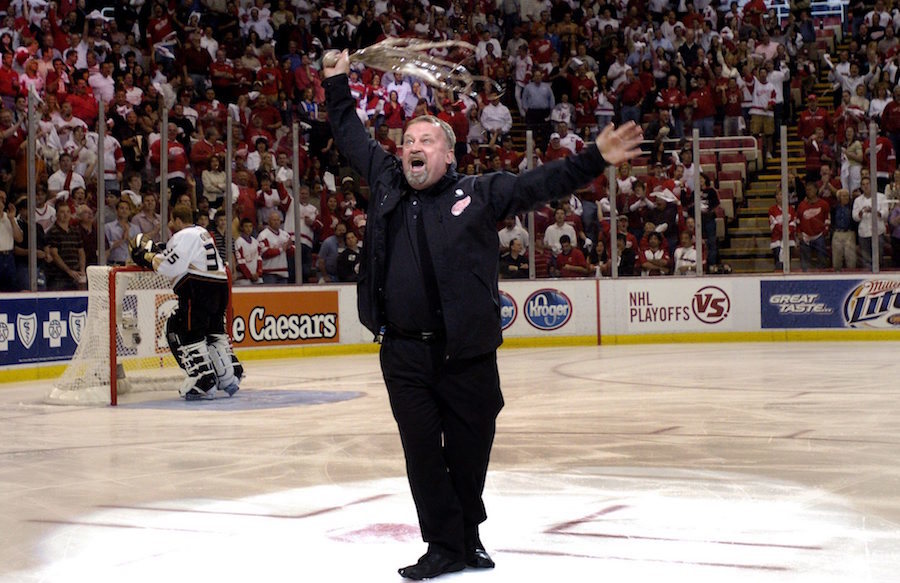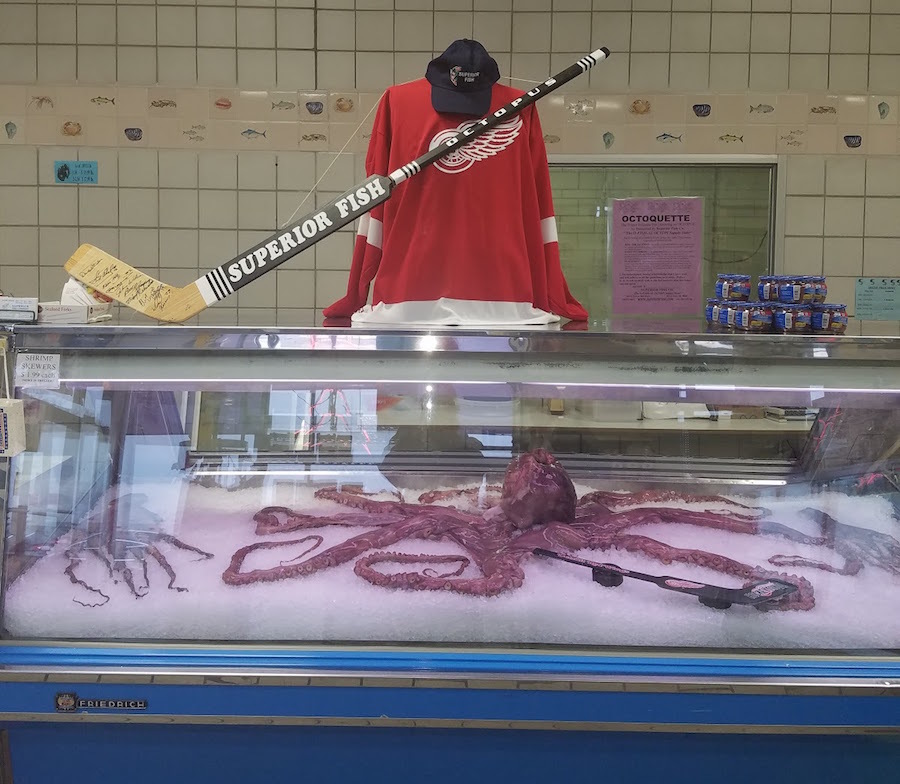The tradition of throwing octopuses at Red Wings games is older than most of the teams in the National Hockey League. Legend has it that the custom of chucking cephalopods in the postseason was the creation of the Cusimano brothers, Pete and Jerry. Owners of a local fish market in Detroit, the pair believed that the octopus made for a natural good luck charm because its eight tentacles symbolized the number of wins needed to secure the Stanley Cup in the Original Six era.
One day, while handling an octopus in the shop, Jerry supposedly picked up a leg and gestured to his brother. As Pete recalled in the Detroit Free Press years later, he remembers Jerry saying, “Here’s the thing with eight legs. Why don’t we throw it on the ice and maybe the Wings’ll win eight straight?” The brothers first put the idea into practice on April 15, 1952, when the Red Wings hosted the Canadiens in what was slated to be the last game in the Stanley Cup Final. At that point, Detroit had a commanding 3-0 series lead, and it was time to put Jerry’s theory to the test. After Gordie Howe scored the first goal of the contest, Pete hopped out of his seat and hurled his stowaway mollusk onto the ice. The Red Wings went on to complete the postseason sweep and nab Lord Stanley’s Mug. The rest, they say, is history.
Videos by VICE
Although the ritual of tossing octopi has become synonymous with Detroit playoff hockey, it wasn’t always the case. After a dominant period that saw the club win back-to-back championships in 1954 and 1955 and reach the Stanley Cup Final nearly every year in the early 1960s, the Red Wings were mired in futility for much of the 1970s and 1980s. As a result, with the team failing to qualify for the postseason year after year, there wasn’t much opportunity to carry on the custom.
READ MORE: How the Hockey World Has Changed Since the Red Wings Last Missed the Playoffs
All of that changed by the end of the 1986-87 campaign, the first with head coach Jacques Demers at the helm. The Red Wings had put together their best season in 14 years and it seemed as though it was high time for the octopi to fly again. So much so that the organization reached out to the Superior Fish Company to help revive the tradition, for what the club hoped would be a long postseason run.
According to Kevin Dean, co-owner of the family business, they were asked by the Red Wings organization and the media to supply them with some octopuses for a photo shoot in the leadup to the postseason that year. “There was a lot of hope and positivity in coach Demers coming to Detroit and giving the Red Wings a chance to bring a Stanley Cup back to Detroit because it had been missing for many, many years,” Dean told VICE Sports.
The Red Wings ended up advancing as far as the conference finals that postseason, and as the ritual returned to vogue, plenty of the octopuses that were flung onto that ice came from Dean and his family. He noted that in a typical postseason when Detroit qualifies, they usually sell around 10 to 15 for every home game in the first round and then it starts heating up. “In 1998, during the Stanley Cup Final, we sold over 100 octopus in a single game day,” he said.
It was around this time that Detroit’s building manager and ice keeper, Al Sobotka, better known for his octopus wrangling, developed his patented twirling technique. Sobotka, now 63, started with the Red Wings back in 1971 when he began working for the Olympia. During those early years he didn’t see many octopi, but by the early 1990s, when the club became a perennial playoff team, the task of collecting the mollusks fell on him, and he dutifully embraced the responsibility.

Al Sobotka, with octopus in hand, on the Joe Louis Arena ice during the 2007 Western Conference final. Photo by Jerry Mendoza/AP
He’s certainly seen his fair share of octopuses over the decades, but he hasn’t been keeping count. “All these 25 years, I wish I knew how many. It would’ve been nice if I kept a spreadsheet on it, but I didn’t. It would be a good question for Trivial Pursuit,” Sobotka told VICE Sports.
Although he can’t put a number on it, there’s a few that stick out. “In 1995 somebody threw a 30-pounder on the ice and as I was walking off with it, a player skated by and says, ‘Swing that.’ And I looked at him and said, ‘Are you crazy? I can’t even wrap my hand around that.’ The head on it was so big, it was bigger than a human’s head,” he recalled.
That gargantuan octopus was an exception. The kind you’re more likely to see are of the four-to-five-pound variety. Sobotka says these ones are the best for twirling because the tentacles really go flying. And the place you’re most likely to buy these from is Superior. Since the tradition was rejuvenated in the late 1980s, they’ve become the premier place to purchase octopus for pitching. But in addition to supplying the cephalopods, Superior has also helped refine the tradition. This has included the development of “octoquette“—a set of three simple rules that focus on preparing the frozen octopus before the game and protocols for throwing. These guidelines are meant to ensure minimal disruptions to the game because, after all, the practice is not officially condoned by the club and Red Wings patrons caught in the act are subject to ejection and can face a supplemental fine of $500 from police.

Home of Superior Fish Co. Photo courtesy of Jim Boyle
Although the Red Wings aren’t in the playoffs for the for the first time in 26 seasons, Superior Fish Co. still received plenty of business as the NHL regular season wound down. This was largely due to the historic final games at Joe Louis Arena in early April. With the closing of Detroit’s most storied hockey building, there was no shortage of fans who were looking to shower the Joe in octopi one last time. “There was almost a Stanley Cup Final, if not more, fervour and desire to buy octopus to throw it out on the ice for the last two home games,” said Dean. “I had a lot of people coming up to me and saying, ‘This is on my bucket list,’ so there was a lot of buckets of octopus thrown out there,” he noted. On the Friday and Saturday leading up to those last games at the Joe, Dean said they sold 45 octopuses alone and had many more purchases throughout the week.
One of those patrons happened to be Jim Boyle. The St. Claire Shores native has been a Red Wings fan his entire life, but had never made a toss. He couldn’t have picked a better time to do it then at the final home game at Joe Louis Arena on April 9. After picking up his octopus from Superior, Boyle followed the ‘octoquette’ and boiled his mollusk before the game. He put his own spin on the process by adding red food colouring to the pot, in the hope that it would help his cephalopod stand out in the crowd. After all, it was a historic night, and he certainly wouldn’t be the only chucker in the stands. Although his attempt at dyeing his octopus didn’t go according to plan, he was undeterred.
After carefully sneaking it into the building, he made his move with 13 minutes remaining in the third period. Taking a baseball stance, he hurled it onto the ice with all his might. Boyle ended up being one of 35 people who tossed an octopus during the last game at Joe Louis. Mission accomplished.
“I would do it again,” Boyle told VICE Sports. “I would probably go to a game at Little Caesars Arena [the Red Wings’ new home] first before going through the rigmarole of sneaking in the octopus, just to learn the ropes. And once I get a little more comfortable with the surroundings then I will probably do it,” he said.
He certainly won’t be the only one. Kevin Dean says he already has customers who have told him to have plenty of octopus on hand for Detroit’s first home game next season. “People are already gearing up in anticipation,” he chuckled. Among those will be Sobotka. He has no plans to retire any time soon, and although he will have a new office next year, he expects he’ll have his hands full.
“The tradition is probably never going to stop. There’s nothing like this in any other sport,” he noted.
Sixty-five years after Pete Cusimano made history by hurling the first octopus onto the ice at the Olympia, it remains one of the most unique traditions in hockey. Even as the Red Wings transition into their new home, there’s no doubt that this ritual will continue for years to come. Although the practice has been criticized recently by some, nothing signifies the NHL playoffs quite like seeing Sobotka twirling an octopus above his head. We can only hope the Red Wings are back in the postseason next year to inaugurate the custom in their new barn.




